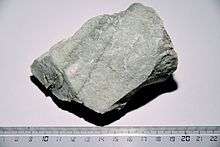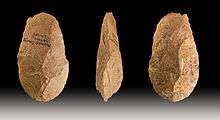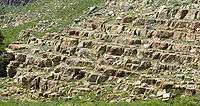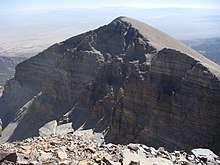Quartzite
Quartzite is a hard, non-foliated metamorphic rock which was originally pure quartz sandstone.[1][2] Sandstone is converted into quartzite through heating and pressure usually related to tectonic compression within orogenic belts. Pure quartzite is usually white to grey, though quartzites often occur in various shades of pink and red due to varying amounts of iron oxide (Fe2O3). Other colors, such as yellow, green, blue and orange, are due to other minerals.

When sandstone is cemented to quartzite, the individual quartz grains recrystallize along with the former cementing material to form an interlocking mosaic of quartz crystals.[1] Most or all of the original texture and sedimentary structures of the sandstone are erased by the metamorphism.[1] The grainy, sandpaper-like surface becomes glassy in appearance.[1] Minor amounts of former cementing materials, iron oxide, silica, carbonate and clay, often migrate during recrystallization and metamorphosis. This causes streaks and lenses to form within the quartzite.
Orthoquartzite is a very pure quartz sandstone composed of usually well-rounded quartz grains cemented by silica. Orthoquartzite is often 99% SiO2 with only very minor amounts of iron oxide and trace resistant minerals such as zircon, rutile and magnetite. Although few fossils are normally present, the original texture and sedimentary structures are preserved.
The term is also traditionally used for quartz-cemented quartz arenites,[3] and both usages are found in the literature. The typical distinction between the two (since each is a gradation into the other) is a metamorphic quartzite is so highly cemented, diagenetically altered, and metamorphosized so that it will fracture and break across grain boundaries, not around them.
Quartzite is very resistant to chemical weathering and often forms ridges and resistant hilltops. The nearly pure silica content of the rock provides little material for soil; therefore, the quartzite ridges are often bare or covered only with a very thin layer of soil and little (if any) vegetation.
Occurrence
In the United States, formations of quartzite can be found in some parts of Pennsylvania, the Washington DC area, eastern South Dakota, Central Texas,[4] southwest Minnesota,[5] Devil's Lake State Park in the Baraboo Range in Wisconsin,[6] the Wasatch Range in Utah,[7] near Salt Lake City, Utah and as resistant ridges in the Appalachians[8] and other mountain regions. Quartzite is also found in the Morenci Copper Mine in Arizona.[9] The town of Quartzsite in western Arizona derives its name from the quartzites in the nearby mountains in both Arizona and Southeastern California. A glassy vitreous quartzite has been described from the Belt Supergroup in the Coeur d’Alene district of northern Idaho.[10]
In the United Kingdom, a craggy ridge of quartzite called the Stiperstones (early Ordovician – Arenig Epoch, 500 Ma) runs parallel with the Pontesford-Linley fault, 6 km north-west of the Long Mynd in south Shropshire. Also to be found in England are the Cambrian "Wrekin quartzite" (in Shropshire), and the Cambrian "Hartshill quartzite" (Nuneaton area).[11] In Wales, Holyhead Mountain and most of Holy island off Anglesey sport excellent Precambrian quartzite crags and cliffs. In the Scottish Highlands, several mountains (e.g. Foinaven, Arkle) composed of Cambrian quartzite can be found in the far north-west Moine Thrust Belt running in a narrow band from Loch Eriboll in a south-westerly direction to Skye.[12] In Ireland areas of quartzite are found across the northwest, with Errigal in Donegal as the most prominent outcrop.
In continental Europe, various regionally isolated quartzite deposits exist at surface level in a belt from the Rhenish Massif and the German Central Highlands into the Western Czech Republic, for example in the Taunus and Harz mountains. In Poland quartzite deposits at surface level exists in Świętokrzyskie Mountains.
In Canada, the La Cloche Mountains in Ontario are composed primarily of white quartzite. The highest mountain in Mozambique, Monte Binga (2436 m), as well as the rest of the surrounding Chimanimani Plateau are composed of very hard, pale grey, Precambrian quartzite. Quartzite is also mined in Brazil for use in kitchen countertops.
Uses

Quartzite is a decorative stone and may be used to cover walls, as roofing tiles, as flooring, and stairsteps. Its use for countertops in kitchens is expanding rapidly. It is harder and more resistant to stains than granite. Crushed quartzite is sometimes used in road construction.[2] High purity quartzite is used to produce ferrosilicon, industrial silica sand, silicon and silicon carbide.[13] During the Paleolithic, quartzite was used, along with flint, quartz, and other lithic raw materials, for making stone tools.[14]
Safety
As quartzite is a form of silica, it is a possible cause for concern in various workplaces. Cutting, grinding, chipping, sanding, drilling, and polishing natural and manufactured stone products can release hazardous levels of very small, crystalline silica dust particles into the air that workers breathe.[15] Crystalline silica of respirable size is a recognized human carcinogen and may lead to other diseases of the lungs such as silicosis and pulmonary fibrosis.[16][17]
Etymology
The term quartzite is derived from German: Quarzit.[18]

 The quartzite of the Prospect Mountain Formation at the top of Doso Doyabi in White Pine County, Nevada
The quartzite of the Prospect Mountain Formation at the top of Doso Doyabi in White Pine County, Nevada- Quartzite from Salangen, South Troms, Norway, showing elongate crystals associated with high strain regimes
 Thin section of quartzite from Salangen, South Troms, Norway, showing elongate crystals associated with high strain regimes
Thin section of quartzite from Salangen, South Troms, Norway, showing elongate crystals associated with high strain regimes
See also
References
- Essentials of Geology, 3rd Edition, Stephen Marshak, p 182
- Powell, Darryl. "Quartzite". Mineral Information Institute. Archived from the original on 2009-03-02. Retrieved 2009-09-09.
- Ireland, H. A. (1974). "Query: Orthoquartzite????". Journal of Sedimentary Petrology. 44 (1): 264–265. doi:10.1306/74D729F0-2B21-11D7-8648000102C1865D.
- Archived May 12, 2007, at the Wayback Machine
- Natural history – Minnesota's geology – SNAs: Minnesota DNR Archived March 9, 2010, at the Wayback Machine. Dnr.state.mn.us (2000-02-17). Retrieved on 2011-06-05.
- Geology by Lightplane. Geology.wisc.edu (1923-07-13). Retrieved on 2011-06-05.
- John W Gottman, Wasatch quartzite: A guide to climbing in the Wasatch Mountains, Wasatch Mountain Club (1979) ISBN 0-915272-23-7
- "Quartzite". 21 May 2009. Archived from the original on 21 May 2009.CS1 maint: BOT: original-url status unknown (link)
- Kennedy, B. A. (ed.). Surface Mining, Chapter 9.4: Case Studies: Morenci/Metcalf Archived 2007-06-25 at the Wayback Machine Society for Mining, Metallurgy, and Exploration, Undated Accessed May 28, 2007
- White, B.G. and Winston, D., 1982, The Revett/St Regis “transition zone” near the Bunker Hill mine, Coeur d’Alene district, Idaho: Idaho Bureau of Mines and Geology Bulletin 24
- Veena (2009). Understanding Geology. Discovery Publishing House. pp. 145–. ISBN 978-81-8356-461-8. Retrieved 5 June 2011.
- John Blunden, (1975), The mineral resources of Britain: a study in exploitation and planning, p. 281.
- Krukowski, Stanley T. (2006). "Specialty Silica Materials". In Jessica Elzea Kogel; Nikhil C. Trivedi; James M. Barker; Stanley T. Krukowski (eds.). Industrial minerals & rocks: commodities, markets, and uses (7 ed.). Society for Mining, Metallurgy, and Exploration (U.S.). p. 842. ISBN 0-87335-233-5.
- http://scholarspace.manoa.hawaii.edu/bitstream/handle/10125/17202/AP-v43n1-73-91.pdf;sequence=1
- Hazard Alert - Worker Exposure to Silica during Countertop Manufacturing, Finishing and Installation (PDF). DHHS (NIOSH). p. 2. Retrieved 27 November 2019.
- "Silica (crystalline, respirable)". OEHHA. California Office of Environmental Health Hazard Assessment. Retrieved 27 November 2019.
- Arsenic, Metals, Fibres and Dusts. A Review of Human Carcinogens (PDF) (100C ed.). International Agency for Research on Cancer. 2012. pp. 355–397. ISBN 978-92-832-1320-8. Retrieved 27 November 2019.
- "German Loan Words in English". German.about.com. 2010-06-22. Archived from the original on 2011-06-07. Retrieved 2011-06-05.
External links
| Wikimedia Commons has media related to Quartzite. |
| Wikisource has the text of the 1911 Encyclopædia Britannica article Quartzite. |
- R. V. Dietrich's GemRocks: Quartzite
- CSU Pomona Geology: Quartzite
- Cowen's "The First Geologists" (chapter on Stone Age/Homo habilis use of quartzite)
- Minnesota Department of Natural Resources : Natural History: Minnesota's geology
- Wisconsin's Baraboo Syncline (map and aerial photos of Baraboo quartzite quarries)
- South Dakota 2002 Mineral Summary: Production, Exploration and Environmental Issues (including 2002 quartzite production)
- Big Sioux River: History of Sioux Falls and Quartzite Photos